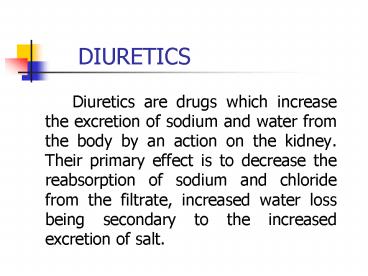DIURETICS - PowerPoint PPT Presentation
1 / 14
Title:
DIURETICS
Description:
DIURETICS Diuretics are drugs which increase the excretion of sodium and water from the body by an action on the kidney. Their primary effect is to decrease the ... – PowerPoint PPT presentation
Number of Views:1706
Avg rating:3.0/5.0
Title: DIURETICS
1
DIURETICS
- Diuretics are drugs which increase the
excretion of sodium and water from the body by an
action on the kidney. Their primary effect is to
decrease the reabsorption of sodium and chloride
from the filtrate, increased water loss being
secondary to the increased excretion of salt.
2
CLASSIFICATION
- High effect diuretics Lasix
- Mediate effect Thiazide diuretics
- Mild (Low)effect K sparing diuretics
- Osmotic diuretics Mannitol
- Others
3
urine formation the action sites of diuretics
- Glomerulus and its filtration
- Tubules and its reabsorption and secretion
- Proximal convoluted tubule
- Na-H-antiporter axetazolamide H
- Ascending limb of the loop of Henle
- dilution concentration
- K-Na-2Cl- -cotransporter
- Distal tubule and collecting duct
- Na - K-exchanger
Na
- Furosemide
- Thiazides
- Spironolactone
- Trianterene
4
High effect diuretics
- High ceiling (loop) diuretics
- Agent
- furosemide (lasix)
- Action site
- thick ascending loop (AL)
- Mechanism
- 1. Cl K-Na-2Cl
5
High effect diuretics
- 2. PGE
- P.E.
- Cl Na
- Renal Blood Flow (RBF)
- ADR
- Ototoxicity (etacrynic acidgtlasixgtbumetanide)
- Disturbance of water and electrolyte
- Hyperuricemia
- Others toxicities allergic reactions,nausea et
al.
- P.K.
- Onset in 5 min by i.v.
- 30 min by p.o.
- t 1/22hr last for 4-6 hr
6
Mediate effect diuretics
- Thiazides
- Agent
- Hydrochlorothiazide (HCT)
- Action site
- Distal convoluted tubule (DCT)
- Mechanism
- Na-K-2Cl PDE
7
Mediate effect diuretics
- ADR
- Hypokalemia ---be careful when use with
digitalis. - Hyperuricemia--- compete with uric acid
- Hyperglycemia--- insulin
- Hypercalcemia--- Ca
8
Low effect diuretics
- K sparing diuretics
- Agent
- Antisterone, Triamterene amiloride
- Action site
- DCT CT (Collecting Tubule)
- Mechanism
- 1. Ald-R
- 2. Na channel
Na K
9
Low effect diuretics
- ADR
- Hyperkalemia, sex hormone like effects
(antisterone) - Others
- Carbonic anhydrase inhibitors (acetazolamide)
- H2O CO2 H HCO3 --------
inside cell - Na -----
outside cell
CA
10
Osmotic diuretics
- Agents (characters)
- Mannitol, Glucose
- Action site
- PCT, AL Vessels, gastrointestinal tract
- Mechanism
- 1. Hyperosmolarity
- 2. Blood volume RBF
11
Osmotic diuretics
- P.E.
- H2O
- ADR
- BV CHF
- Dehydration
- Hypernatremia
12
CLINIC USES of DIURETICS
- Edema
- CHF
- ARF
- Hypertension
- Poisoning
- Hypercalciuria
- Hypercalciumia
- Glaucoma
- Diabetes insipidus
13
ADR of Diuretics
Pla. K Pla.UricA Pla.Ca ototoxicity others
H.D (Lasix) _ _ BV _
M.D (HCT) _ _ LDL
L.D (antisterone) _ _ Sex H effects
In common Hyponatremia, electrolyte imbalances Hyponatremia, electrolyte imbalances Hyponatremia, electrolyte imbalances Hyponatremia, electrolyte imbalances Hyponatremia, electrolyte imbalances
14
Review questions
- The classes of diuretics.
- The mechanisms of each.
- The Common ADR of diuretics
- The common P.E of diuretics
- The clinic uses of diuretics.































